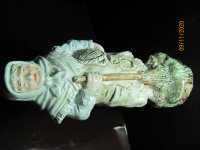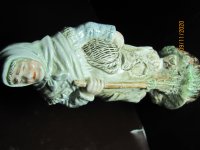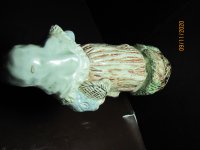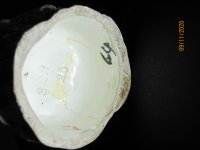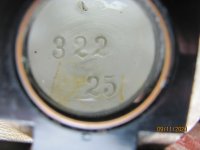You are using an out of date browser. It may not display this or other websites correctly.
You should upgrade or use an alternative browser.
You should upgrade or use an alternative browser.
interesting small figure of old lady,from what country, Germany,England.
- Thread starter freddo
- Start date
Red-Coat
Gold Member
Hi Freddo
While I cannot identify your figurine, I’ll leave these thoughts with you.
The subject matter and styling of ‘peasant’ figurines like this are not a reliable indicator of their origin. Most of the unmarked pieces were made in Japan or Taiwan for export to the West.
During the late 1800s and early to mid 1900s (excluding the WWI & WWII periods), there were numerous operations set up in the Orient with the assistance of European and American entrepreneurs to produce home-décor porcelain pieces for export to the West. In some cases these producing factories gained sufficient prestige that the importer was happy for them to be marked (Noritake-ware is a good example) but in most cases the pieces were not marked because there was no such prestige. Such marks might even be perceived as detracting from desirability or undermining the marketing intent that the purchasers perceived they were getting a quality European piece. Where they exist, mould identifications, style numbers and inventory codes are usually in the Western alphabet.
The legal requirements for country of origin marking (as imposed by the McKinley Tariff Act in the US from 1891 onwards) could be fulfilled by applying an adhesive foil label with the required information such that the piece itself didn’t need to be marked. Sometimes those foil labels would have the name of the agent or retailer who had commissioned the pieces to enhance their desirability, and sometimes not. In any case, the labels can be subsequently removed, leaving the piece anonymous.
These entrepreneurs would commission pieces in western styles, often providing the mould-makers with European pieces which they wanted copied… most usually ‘in the style of…’ rather than exact copies. Typically the figurines are romanticised depictions of wizened old folk in pinafores or overcoats (plus perm any combination of: walking sticks, brooms, farm tools, logs, shopping baskets, loaves of bread etc); or young gentry in crinolines and frock coats (plus perm any combination of: flower posies, kittens, puppies, picnic baskets, swords etc). The commercial benefit was the low cost production versus sources in Europe and cheaper still in soft-paste rather than true hard-paste porcelain.
If you Google for figurines by companies such as Wales (of Japan), Ardco, Ardalt, UCGC, Norleans, Napco (to name but a few of the larger operations) you will see dozens and dozens of pieces in European stylings… but all made in the Far East. The smaller and less prestigious the maker, the less likely the pieces are to be marked… other than by a foil label which may no longer be present. I see a faint outline below the mould marks which is where a foil label once might have been.
It could be European, but I doubt it. Without a factory mark or a label, it may remain a mystery.
While I cannot identify your figurine, I’ll leave these thoughts with you.
The subject matter and styling of ‘peasant’ figurines like this are not a reliable indicator of their origin. Most of the unmarked pieces were made in Japan or Taiwan for export to the West.
During the late 1800s and early to mid 1900s (excluding the WWI & WWII periods), there were numerous operations set up in the Orient with the assistance of European and American entrepreneurs to produce home-décor porcelain pieces for export to the West. In some cases these producing factories gained sufficient prestige that the importer was happy for them to be marked (Noritake-ware is a good example) but in most cases the pieces were not marked because there was no such prestige. Such marks might even be perceived as detracting from desirability or undermining the marketing intent that the purchasers perceived they were getting a quality European piece. Where they exist, mould identifications, style numbers and inventory codes are usually in the Western alphabet.
The legal requirements for country of origin marking (as imposed by the McKinley Tariff Act in the US from 1891 onwards) could be fulfilled by applying an adhesive foil label with the required information such that the piece itself didn’t need to be marked. Sometimes those foil labels would have the name of the agent or retailer who had commissioned the pieces to enhance their desirability, and sometimes not. In any case, the labels can be subsequently removed, leaving the piece anonymous.
These entrepreneurs would commission pieces in western styles, often providing the mould-makers with European pieces which they wanted copied… most usually ‘in the style of…’ rather than exact copies. Typically the figurines are romanticised depictions of wizened old folk in pinafores or overcoats (plus perm any combination of: walking sticks, brooms, farm tools, logs, shopping baskets, loaves of bread etc); or young gentry in crinolines and frock coats (plus perm any combination of: flower posies, kittens, puppies, picnic baskets, swords etc). The commercial benefit was the low cost production versus sources in Europe and cheaper still in soft-paste rather than true hard-paste porcelain.
If you Google for figurines by companies such as Wales (of Japan), Ardco, Ardalt, UCGC, Norleans, Napco (to name but a few of the larger operations) you will see dozens and dozens of pieces in European stylings… but all made in the Far East. The smaller and less prestigious the maker, the less likely the pieces are to be marked… other than by a foil label which may no longer be present. I see a faint outline below the mould marks which is where a foil label once might have been.
It could be European, but I doubt it. Without a factory mark or a label, it may remain a mystery.
Last edited:
- Thread starter
- #3
Hi Roger
Again many thanks for your opinion and information,you may be right,these things are always a mystery until we come across other information,such as the missing labels or some other evidence.
Very bored at the moment here in Melbourne ,Australia ,we have been in lock down for the last 6weeks,2weeks to go at least,not much fun also 5klm limit.
Regards Freddo .
Again many thanks for your opinion and information,you may be right,these things are always a mystery until we come across other information,such as the missing labels or some other evidence.
Very bored at the moment here in Melbourne ,Australia ,we have been in lock down for the last 6weeks,2weeks to go at least,not much fun also 5klm limit.
Regards Freddo .
Top Member Reactions
-
 2284
2284 -
 1109
1109 -
 1026
1026 -
 912
912 -
 863
863 -
 767
767 -
 754
754 -
 738
738 -
 608
608 -
 504
504 -
 490
490 -
 480
480 -
 430
430 -
 421
421 -
O
415
-
 407
407 -
 401
401 -
 395
395 -
 378
378 -
 370
370
Users who are viewing this thread
Total: 2 (members: 0, guests: 2)
